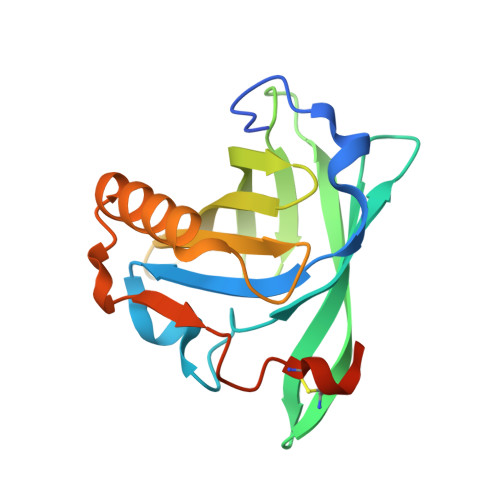Crystal structure of the dog allergen Can f 6 and structure-based implications of its cross-reactivity with the cat allergen Fel d 4.
Yamamoto, K., Ishibashi, O., Sugiura, K., Ubatani, M., Sakaguchi, M., Nakatsuji, M., Shimamoto, S., Noda, M., Uchiyama, S., Fukutomi, Y., Nishimura, S., Inui, T.(2019) Sci Rep 9: 1503-1503
- PubMed: 30728436
- DOI: https://doi.org/10.1038/s41598-018-38134-w
- Primary Citation of Related Structures:
5X7Y - PubMed Abstract:
Several dog allergens cause allergic reactions in humans worldwide. Seven distinct dog allergens, designated Canis familiaris allergen 1 to 7 (Can f 1-Can f 7), have been identified thus far. Can f 6 shows high sequence similarity and cross-reactivity with Fel d 4 and Equ c 1, major cat and horse allergens, respectively. This study was conducted on the allergenic epitopes of Can f 6 based on its structural characterization. We demonstrated that sera from 18 out of 38 (47%) dog-sensitized patients reacted to recombinant Can f 6 protein (rCan f 6). We then determined the crystal structure of rCan f 6 by X-ray crystallography, which exhibited a conserved tertiary structural architecture found in lipocalin family proteins. Based on the tertiary structure and sequence similarities with Fel d 4 and Equ c 1, we predicted three IgE-recognizing sites that are possibly involved in cross-reactivity. Substituting three successive amino acids in these sites to triple alanine decreased IgE reactivity to the allergen. However, the degree of reduction in IgE reactivity largely depended on the site mutated and the serum used, suggesting that Can f 6 is a polyvalent allergen containing multiple epitopes and Can f 6-reactive sera contain varied amounts of IgE recognising individual Can f 6 epitopes including those predicted in this study. We also demonstrated that the predicted epitopes are partly involved in IgE cross-reactivity to Fel d 4. Interestingly, the effect of the mutation depended on whether the protein was structured or denatured, indicating that the bona fide tertiary structure of Can f 6 is essential in determining its IgE epitopes.
- Department of Applied Life Sciences, Graduate School of Life and Environmental Sciences, Osaka Prefecture University, 1-1 Gakuen-cho, Naka-ku, Sakai, 599-8531, Japan.
Organizational Affiliation:

















